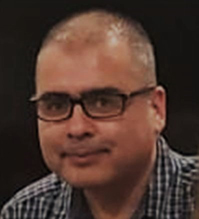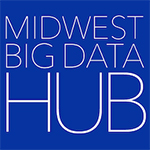By Barbara Jewett
This story is part of a series on coronavirus research in the Midwest region
Many researchers in the Midwest received awards from the National Science Foundation last year for developing novel masks and other personal protective equipment.

One of those researchers, Leonardo P. Chamarro, an associate professor in the Department of Mechanical Engineering at the University of Illinois at Urbana-Champaign, was awarded a special one-year, $200,000 RAPID grant to design a 3D-printable medical mask inspired by the nasal structures of animals. Working with Associate Professor Sunghwan Jung at Cornell University and Assistant Professor Saikat Basu at South Dakota State University, the team hopes their design addresses mask shortages and improves existing face protection by providing an open-source template for use with 3D printers.
The team captured small aerosol droplets that can carry viruses from inhaled air using a combination of copper-based filters and twisted periodic thermal gradients induced by spiral copper wires that mimic nasal pathways. The aerosol capture was articulated by modulating the dynamics of flow structures in the convoluted geometry (a vortex trap) and by thermophoresis action along the respirator’s internal walls (a thermal trap). Cyclic cold/hot temperature changes on the walls, along with ionic activity from the copper material, is used to inactivate the trapped viruses.
Dr. Chamorro took time away from his research to answer five questions about his COVID-19 research:
What’s the problem you’re trying to solve, and how is your team addressing it?
We are focused on exploring ways to mitigate the COVID-19 pandemic transmission and understand the role of turbulence [in virus spread]. In particular, we are collaborating with Sunny Jung at Cornell University and Saikat Basu at South Dakota State University in the development of a novel bio-inspired protective mask based on thermal and vortex traps. [We are also collaborating] with researchers at Purdue, Rensselaer Polytechnic Institute, the National Autonomous University of Mexico, and Tsinghua University in Beijing in the development of an autonomous robot for scanning, data mining, and disinfection. [In another project] we are also collaborating with a team at Northwestern on the description of contaminated droplet dynamics. My team uses theory, state-of-the-art flow diagnostics tools at various scales, and in-house analysis tools.
What’s changed since this project started last year?
It is a question that has many layers. The more we learn, the more we realize that several fundamental gaps need to be addressed to prepare for the next pandemic. Changes have occurred at various levels.
What data are you working with? Are there data challenges you’re dealing with? Are you using public data resources? Are you producing data that others are using?
We focus on the dynamics of droplets and aerosols and the interaction with closed domains at a range of scales. It requires performing experiments, capturing three-dimensional particle and flow dynamics, and, consequently, we produce our data. High-fidelity tracking of many particles and flow filed simultaneously in space and time is not trivial; however, my team has developed the needed technology to face those challenges.
Is your team seeking collaborators, subject matter experts, or other resources that you’d like to put a call out for?
Yes, we would very much like to collaborate at the fundamental and applied levels on various pressing problems, including, but not limited to, the role of turbulence across scales, ventilation, and boundary conditions.
Where can people learn more about your progress?
So far, we have contributed to two peer-reviewed papers. One paper in Extreme Mechanics Letters on the performance of various fabrics in homemade masks and another paper is in advanced stages of review in PNAS. My group also gave four technical talks on COVID research at the last American Physical Society in November, and we are updating our webpage to share recent findings.
Other PPE Projects
There are numerous other PPE projects in the Midwest that received Rapid Response Research grants. Here are a few of them:
- Safely returning to using reusable equipment, including some PPE, is the focus of an award to Andrea Hicks, an assistant professor of civil and environmental engineering at the University of Wisconsin–Madison. You can read more about her work here.
- Producing masks that capture and neutralize viral pathogens by adapting a decade of work developing a proprietary composite nanofiber material for water filtration is the focus of collaborators David Cwiertny, a professor of civil and environmental engineering and director of the Center for Health Effects of Environmental Contamination at the University of Iowa, and Nosang Myung, the Keating Crawford Endowed Professor in Chemical and Biomolecular Engineering at Notre Dame. Cwiertny received an award for this research project and Myung also received an award. You can read more about their work here and also here.
- Developing smart face masks embedded with battery-free sensors to assess proper fit and monitor health is the focus of the award received by Northwestern’s Josiah Hester, an assistant professor of electrical and computer engineering. You can read about his work here.
- Developing a new self-sanitizing medical face mask that deactivates viruses on contact earned an award for Northwestern materials science professor Jiaxing Huang. You can read about his work here.
- Exploring coating the surface of PPE with copper and zinc oxide nanoparticles to limit the spread of viral particles is the subject of an award for Robert DeLong, an associate professor in the Nanotechnology Innovation Center at Kansas State.
Get involved
Contact the Midwest Big Data Innovation Hub if you’re aware of other projects we should include here, or to participate in any of our community-led Priority Areas.
The Midwest Big Data Innovation Hub is an NSF-funded partnership of the University of Illinois at Urbana-Champaign, Indiana University, Iowa State University, the University of Michigan, the University of Minnesota, and the University of North Dakota, and is focused on developing collaborations in the 12-state Midwest region. Learn more about the NSF Big Data Hubs community.
